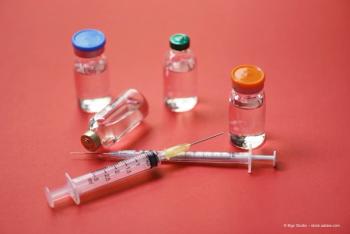
Aflibercept rivals laser for diabetic retinopathy
Intravitreal aflibercept worked better than panretinal photocoagulation (PRP) for proliferative diabetic retinopathy (PDR) in a new head-to-head trial, according to researchers.
Intravitreal aflibercept worked better than panretinal photocoagulation (PRP) for proliferative diabetic retinopathy (PDR) in a new head-to-head trial, according to researchers.
Patients given four intravitreal injections of aflibercept for a year gained four Early Treatment Diabetic Retinopathy Study (ETDRS) letters more in mean best-corrected visual acuity (BCVA) than patients treated with PRP, researchers noted.
It was the first time an anti-vascular endothelial growth factor (VEGF) treatment has topped the laser in a trial of treatments for diabetic retinopathy without macular oedema, said chief investigator Dr Sobha Sivaprasad, consultant ophthalmologist at Moorfields Biomedical Research Centre in London, United Kingdom.
“These are significant findings for an eye condition that has been treated with PRP as standard of care for the past 40 years, as they demonstrate that aflibercept could potentially be adopted as an alternative treatment option, in year one, in compliant PDR patients in the future,” she said in a press release.
Dr Sivaprasad and colleagues presented the finding from the UK CLARITY trial on 9th May at the Association for Research in Vision and Ophthalmology (ARVO) annual conference in Baltimore, Maryland, USA, and published it online in
PRP reduces the risk of severe vision loss from proliferative diabetic retinopathy by more than 50%. But repeated PRP itself can cause loss of visual acuity.
Because of the success of anti-VEGF drugs in treating other eye diseases involving neovascularisation, researchers have begun exploring them as treatments for diabetic retinopathy as well.
A recent randomised clinical trial comparing another anti-VEGF, ranibizumab, to PRP for patients with high-risk PDR, with and without macular oedema, showed that ranibizumab was “non-inferior” to PRP after two years, with less visual field loss and incident vitrectomy.
Study design
For the study, Dr Sivaprasad and her colleagues randomly assigned 232 people with proliferative diabetic retinopathy to either repeated intravitreal aflibercept or PRP for 52 weeks. Many of these dropped out or were found not to meet the criteria for inclusion.
After a year, 104 patients remained in the aflibercept group and 106 remained in the laser group. The patients had a baseline BCVA of fewer than 90 letters.
Patients in the aflibercept group received an intravitreal injection of 2 mg/0.05 mL at baseline, four weeks, and eight weeks. From week 12, patients were reviewed every four weeks and received aflibercept injections as needed on the basis of the extent of regression and reactivation of neovascularisation of the optic disc.
Also taken into account were clinical examinations and a comparison of seven-field colour photographs or wide-field photography at screening or previous visit.
Over the year, aflibercept patients received a mean of 4.4 injections, including the three mandated loading doses. Patients who had had no prior treatment received a mean of 4.6, while those who had been treated with PRP received a mean of 4.1.
The mean difference in the BCVA letter score between the aflibercept and PRP arms was smallÂÂÂÂÂÂÂÂÂ-3.9 letters-but it was statistically significant (p < 0.0001), and slightly higher if the patients who dropped out were not considered. It was achieved with a median of one aflibercept injection in the 40 weeks post-loading phase.
Encouraging results
At 52 weeks, 89% of patients in the aflibercept group had no macular oedema, compared with 71% in the PRP arm. The incidence of vitreous haemorrhage was 18% in the PRP group, compared to 9% in the aflibercept group.
Five percent of the patients in the aflibercept group improved by at least ten letters compared with only 2% of the patients in the PRP group. However, the difference was not statistically significant (p = 0.45).
Only two patients required supplementary PRP in the aflibercept group.
From week 12, 65% of patients in the PRP arm required supplementary PRP. The mean number of supplementary PRP sessions required was 1.17, with patients receiving their first treatments having a mean of 1.35 supplementary sessions and the others averaging a mean of 0.96.
In the PRP arm, 69% received multi-spot laser, whilst the remaining patients received single spot laser.
This investigator-initiated study was funded predominantly by the UK Efficacy and Mechanism Evaluation programme and managed by the National Institute for Health Research on behalf of the Medical Research Council. The treatment, aflibercept solution for injection, was supplied by Bayer Plc, Reading, UK. Bayer also provided an unrestricted grant toward study costs.
Dr Sivaprasad received research grants, travel grants, speaker fees and attended advisory board members of Novartis, Bayer, Allergan and Roche. The co-lead for the study has received research grants, travel grants, speaker fees and attended advisory board members of Novartis, Bayer and Allergan. The other named authors declare that they have no competing interests.
Aflibercept is not approved for PDR in the UK; it is only approved for neovascular age-related macular degeneration and for visual impairment due to macular oedema secondary to retinal vein occlusion, diabetic macular oedema, or myopic choroidal neovascularisation.
Newsletter
Keep your retina practice on the forefront—subscribe for expert analysis and emerging trends in retinal disease management.










































